As edge computing gateway technology continues to mature and spread, its role in accelerating the advent of the era of intelligence is becoming more and more significant. These compact and powerful devices push data processing and decision-making capabilities closer to the data source. It greatly reduces the latency of data transmission and improves the responsiveness and efficiency of the system. Before we talk about edge computing gateways, we first need to understand what edge computing is and how it differs from distributed computing.
Edge Computing and Distributed Computing
Although edge computing and distributed computing are both innovations in computing models, they show significant differences in architectural design, data processing methods and practical application scenarios. Distributed computing focuses on dividing tasks into small pieces, assigning them to multiple computers in the network for processing, and finally aggregating the results to realize the parallelization of large-scale computing. It focuses more on the efficient use of computing resources and the rapid completion of tasks without placing special emphasis on the geographic location or real-time nature of the data. Distributed computing is widely used in financial data analysis, weather forecast modeling, gene sequencing, and other fields that require high-performance computing support. The power of clusters is used to solve tasks that are difficult for individual computers to accomplish.
In contrast, edge computing emphasizes pushing computing resources, data storage, and analytics to the edge of the network to reduce data transfer latency and reduce reliance on central cloud bandwidth. This model is particularly suited to scenarios where real-time performance is critical. Examples include industries such as the Internet of Things (IoT), autonomous driving, and smart manufacturing.

Pasarela Edge Computing
Pasarela Edge Computing, not only a transit station for data transmission, but also a core hub for intelligent processing, security control and real-time response. With edge computing technology at its core, Edge Computing Gateway is able to perform preliminary processing and analysis near the source of data generation. It reduces the burden of cloud servers and lowers the delay and bandwidth consumption of data transmission. Edge computing gateway is powerful enough to realize data collection, data processing and analysis, logical judgment, encrypted transmission and other functions.
Among many gateways, EG series edge computing gateway of IOTRouter stands out. It not only supports a variety of communication protocols and industry protocols, supports 99% of PLC protocols, but also supports a variety of hardware interfaces, and perfectly interfaces with all kinds of devices. Not only that, it can also support Node-RED secondary development. Through the built-in intelligent algorithms or secondary development of algorithmic logic, it can analyze the collected data in real time, quickly identify and respond to abnormal situations. It provides strong technical support for intelligent manufacturing, smart cities, remote medical care and other fields. In addition, EG Edge Computing Gateway has strong security protection and retransmission capability. Through encrypted transmission, access control and other means, it ensures the security and privacy protection of data during transmission.


Operation Process of Edge Computing Gateway
1. Data Acquisition
The Edge Computing Gateway collects data from the surrounding environment in real time through a variety of transmission methods such as sensors, smart devices, and cameras. These data can include temperature, humidity, video surveillance information, device status, and so on. Through interfaces, the edge computing gateway can flexibly access different types of devices, and data with different protocols can be collected uniformly and processed further.
2. Data processing
Immediately after data collection, the edge computing gateway performs preliminary processing of this data. This phase mainly includes data cleaning, data filtering and data analysis. Due to its high edge computing power, the edge computing gateway is able to execute complex algorithms locally and quickly without sending all the data to the cloud. This not only improves the efficiency of data processing, but also reduces the consumption of network bandwidth.
3. Data Feedback
After processing, the edge computing gateway is able to give immediate feedback. This includes real-time alerts, commands sent to downstream devices (e.g., IoT devices), or visualization of the data. Through the edge computing gateway, the actual response can be realized with low latency, which is extremely important for many scenarios that require immediate response.
4. Data storage
Although edge computing gateways process a large amount of data locally, this data still needs to be stored for subsequent analysis and decision-making. Edge computing gateways usually have a certain storage capacity, and can store real-time data in local databases, while uploading part of the data to the cloud at regular intervals, forming a cloud-edge cooperative data processing architecture. This approach allows important data to be accessed quickly when needed, while historical data can be further analyzed in the cloud.

Summary
Looking ahead, with the further development of 5G, IoT and other technologies, edge computing gateways will play an even more central role. They will no longer be just a transit station for data processing, but will become the intelligent brain in the intelligent ecosystem. Through close collaboration with other intelligent devices, they will jointly promote the full arrival of the intelligent era. In this process, the technological innovation and application expansion of edge computing gateways will continue to deepen, bringing unprecedented changes and opportunities to human society.